In 2004, the Chinese government continued to pay great attention to the rural poverty problem, worked out and implemented a series of policies and measures preferential for farmers, enhanced the government financial support to ¡°Three Aspects of Agriculture, Rural Area and Farmers¡±, reduced the tax burden of farmers greatly, especially of those in poor area, speeded up the construction of the rural social security system in order to assure the low-income farmers mainly with the income from the agricultural production and other weak groups of people obtain the wide benefit. Through the joint efforts of all the society, the anti-poverty work in the rural area got the new progress.
First, the basic condition of the rural social economic development in 2004
1. Agricultural Development
In 2004, the national value-added of primary industry reached 2074.4 billion yuan, up 6.3%. The annual output of grain was 469.47 million tons, up by 38.77 million tons or a rise of 9.0%; that of cotton was 6.32 million tons, up 30.1%; that of oil crops was 30.57 million tons, up 8.8%; that of sugar crops was 95.28 million tons, declining 1.2%. The production of vegetables and fruits developed steadily on the base of expanding high-quality species. The annual total output of meat was 72.6 million tons, a year-on-year rise of 4.7%. The annual yield of aquatic products was 48.55 million tons, up 3.2%.
2. Farms¡¯ Income
In 2004, the net income of residents in the rural area was 2936 yuan, up by 314 yuan over last year or a rise of 12%; eliminating the influence from price, the real rise was 6.8%, setting up the highest growth rate since 1997. Thanks to a series of policies supporting agriculture and taking agriculture as a priority, the rise of grain¡¯s price in the market and climate suitable for the agricultural production, the income from agricultural production by farmers increased dramatically. In 2004, the per capita income of farmers from agricultural production was 176 yuan, up 20%, setting up the new record since the reforming and opening up. The revenue of poor farmers and those with low-income who are mainly engaged in agricultural production increased to a great extent. Based on five groups divided by the per capita income of rural households, the income of low-income group grew 16.3% in nominal aspect, 4.3 percentage points higher than the national average level and 7.1 percentage points higher than the high-income group.
3. Farmers¡¯ Livelihood
In 2004, the per capita consumption expenditure of rural residents was 2185 yuan, up by 241 yuan, if eliminating the price influence, a real rise of 7.3%, which has been the highest rise since 1997. The expenditure in eating, clothes, housing, daily-used articles, education, health, transport and communications rose unanimously, the property and quantity of facilities of farmers for living increased with the enhanced quality. (See table 1 for details)
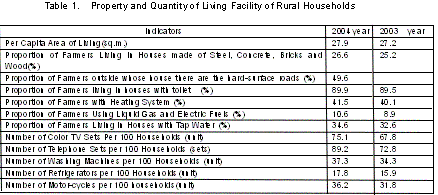
4. Income Distribution
In 2004, the Geordie coefficient of income distribution within rural residents was 0.3692, up by 0.0012 over last year and lower than the 0.0034 of last year¡¯s growth rate. The income distance between urban and rural residents roughly stayed on the same level of 3.2:1 of last year.
5. Rural Social Security
In 2004, there were 333 counties(cities) in which the new rural cooperative medical treatment trial projects have been carries out, covering about 106.91 million rural population. And the number of farmers actually taking part in the above new rural cooperative medical treatment trial project was 80.4 million persons. The rural lowest-income security system began carrying out in some regions.
Second, poverty situation in the national rural area
1. Poverty Standard
According to the consumer price index of rural residents¡¯ living, the standard of absolutely poor population in 2004 was adjusted to 668 yuan from 637 yuan of last year, the standard of low-income population was adjusted to 924 yuan from 882 of last year.
2. Poverty Scale and Degree
At the end of 2004, the rural population in the situation of absolutely poverty was 26.1 million persons, a decline of 2.9 million persons, and accounted for 2.8% with a drop of 0.3 percentage point over last year; the low-income rural population with sufficient but not steady foods and clothes was 49.77 million persons, a drop of 6.4 million persons, and accounted for 5.3%, a decline of 0.7 percentage point.
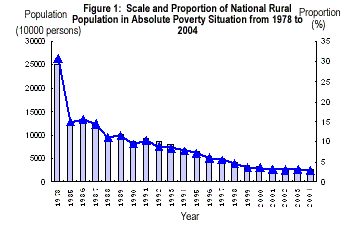
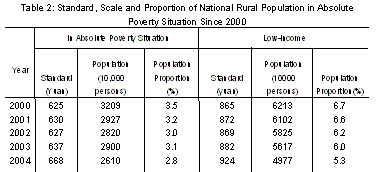
3. Poverty Distribution
Among the rural population in the absolute poverty, those in the eastern region were 3.74 million persons, those in the central region were 9.31 million persons, those in the western region were 13.05 million persons, accounting for 1.0%, 2.8% and 5.7% respectively in local rural population£»among the low-income population, those in the eastern region were 8.37 million persons, those in the central region were 17.44 million persons, those in the western region were 23.96 million persons, taking up the 2.2%, 5.3% and 10.5% of all the local rural population respectively.
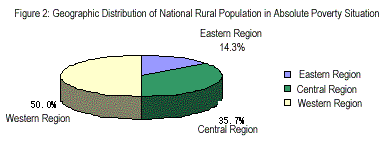
Thirdly, the progress of 592 Key Counties in National Poverty-relieving Development Project
In 2004, the poverty situation in the 592 key counties in the National Poverty-relieving Development Project ( Briefed as Key counties in poverty-relieving development project) was alleviated significantly. The details were as follows:
1. Decline of Poor Population
In 2004, the rural population in the absolute poverty situation in the key counties of poverty-relieving development project was 16.13 million persons, a drop of 1.49 million persons over last year, and took up 8.1% which declined by 0.8 percentage point; the rural population with low-income was 25.8 million persons, a drop of 3.66 million persons, and accounted for 12.9%, down by 1.9 percentage points. The rural population in the absolute poverty situation in the key counties of poverty-relieving development projects took up 61.8% of the national population of this kind, the low-income population in the above-mentioned regions accounted for 51.8% of the national population of this kind.
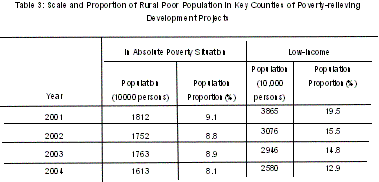
2. Improvement of Farmers¡¯ Living Standard
In 2004, the per capita net income of rural residents in the key counties of poverty-relieving development project was 1582 yuan, a year-on-year rise of 176 yuan or up 12.5%; eliminating the inflation factor, a real rise of 7.3% which was 0.5 percentage point higher than the national average level. The per capita consumption expenditure was 1392 yuan, rising by 172 yuan over last year, if excluding the influence from price rise, a real rise of 8.7% which was 1.4 percentage points higher than the national average level. The Engel coefficient reached 53.2% with the decline of 0.5 percentage point. The property and living facility of rural households increased. (See Table 4 for details)
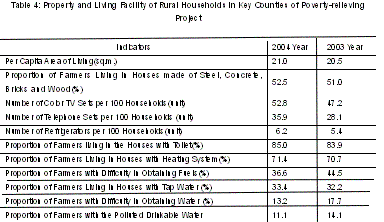
3. Continuous Improvement of Fundamental Facility
In 2004, the number of villages with the highway, electricity supply, phone communications services, receiving services of TV programs, sanitation offices, kindergartens and training lessons before elementary schools in the key counties within the poverty-relieving development project increased and accounted for greater proportion among all the villages compared with last year. (see Table 5 for details)

4. Taxes burden declined greatly.
The per capita taxes and fees of farmers in the key counties within poverty-relieving project in 2004 was 24.1 yuan, a year-on-year drop of 19.2 yuan or a decline of 44.4%. The proportion of taxes and fees in net income of farmers dropped to 1.5% from the 3.1% of 2003 year. The low-income farmers received more benefit from tax reduction measures: the lowest-income 20% farmers obtained the most relief in tax with the reduction of 53.7%; the second lowest-income 20% farmers obtained the 48.4% reduction in tax burden.
5. Improvement in cultural education
In 2004, the proportion of illiterates among the labors in the key counties within poverty-relieving project was 14%, down by one percentage point over last year. The proportion of children between seven and fifteen ages (at year-end, the proportion of number of student at school in all the persons of the same age range) was 93.5%, 1.3 percentage point higher over last year; that between seven and twelve ages was 95.8%, up 0.6 percentage point, that between thirteen and fifteen ages was 90.7%, up by 2.3 percentage points.
6. Condition difference reduced between female and male.
In 2004, among the absolute poverty population in the key counties within the poverty-relieving project, 48.2% were female, the occurrence rate of poverty among females was 8.3%, 0.4 percentage point higher than that of males. Among the low-income population, the 48.5% were female, and the occurrence rate of low-income situation among the female was 13.2%, 0.6 percentage points higher over the male population. Analyzed from most indicators, the positions of females in education, employment, social participation and so on have been improved unanimously, and the differences between female and male have been reduced. (See table 6 for details)
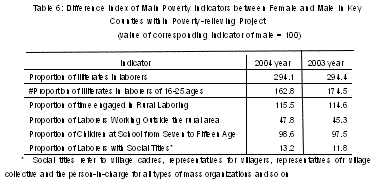
However, the risk-preventing capability of farmers in the key counties within the poverty-relieving projects was still weak. The highlights of such weakness were as follows:
1). The farmers turning into poverty again due to disasters and diseases were in a large proportion. In 2004, the grain output of the 40% administrative villages in the key counties within the poverty-relieving projects reduced by over 30% due to natural disasters. Among the rural households turning into poverty again in this year, the number of households affected by the serious natural disasters accounted for 42.2%, the number of households with the handicapped and serious diseases took up 26%.
2) The laborers faced the narrow vocational scope. In 2004, there were 81.8% rural laborers working in the primary industry in the key counties within the poverty-relieving projects, there were 16.6% laborers working outside their permanent residency, the number of laborers working outside their permanent residency and the income of laborers presented the slowing growth rate in the two consecutive years. There were 80% laborers who never go out to work. The over two-thirds of laborers working outside their permanent residency concentrated in the industries such as construction, manufacturing, mining and catering services.
